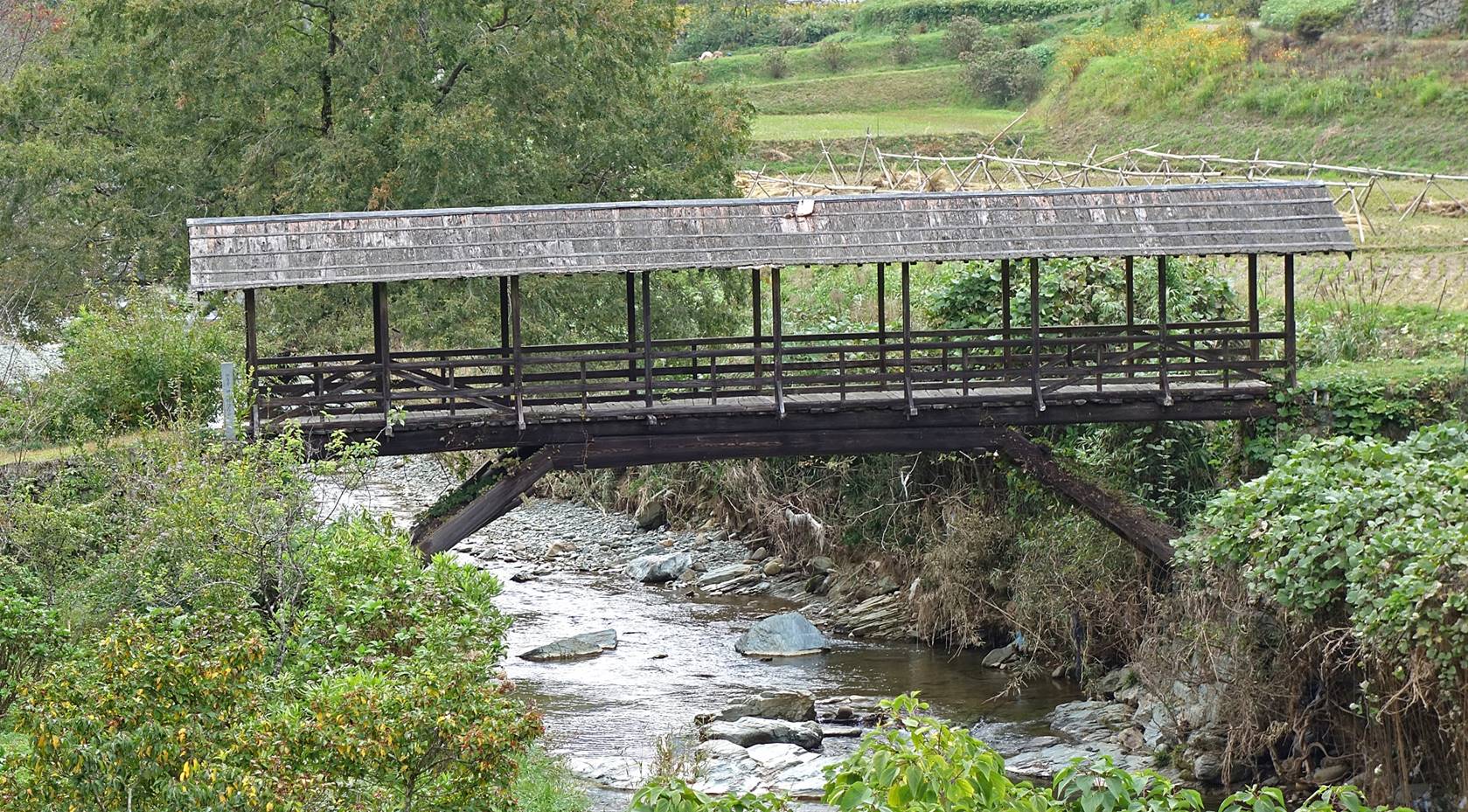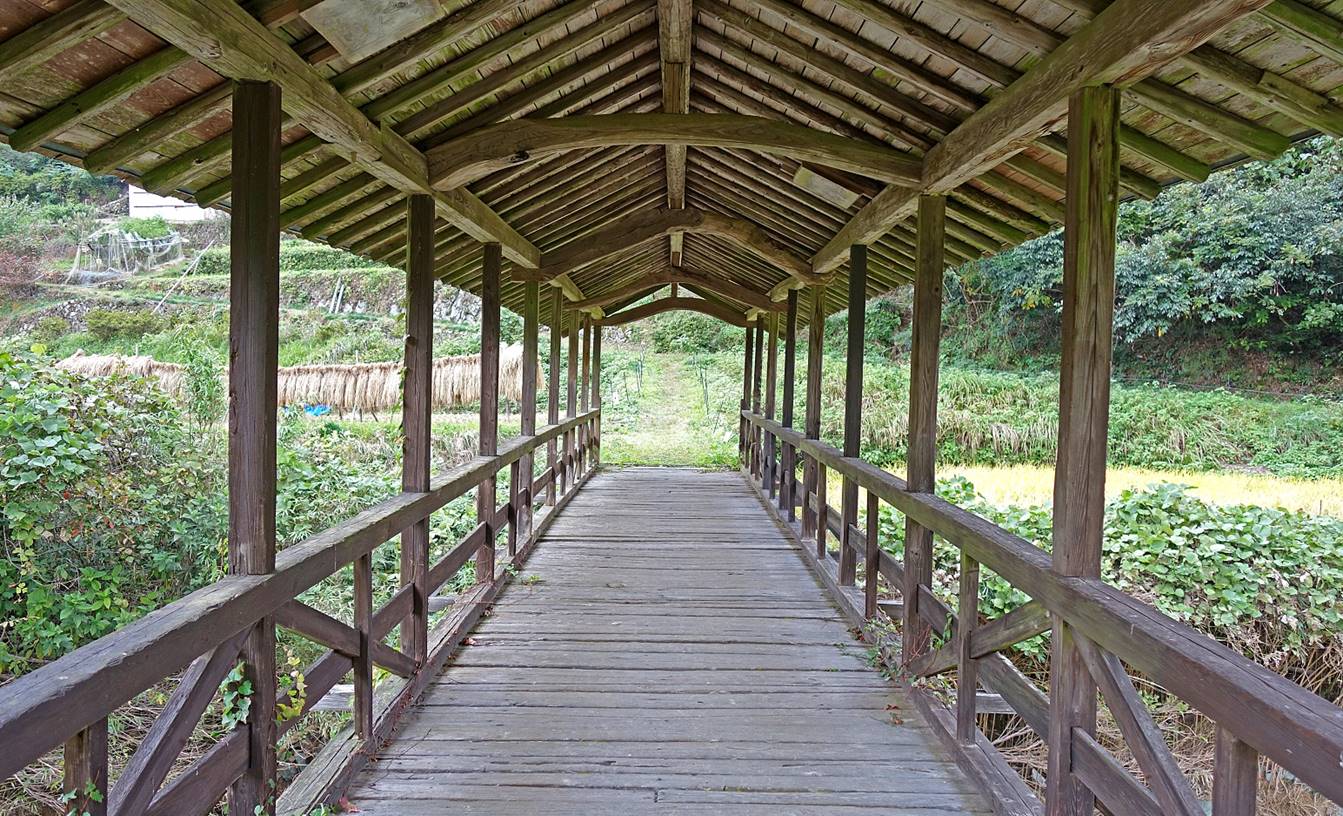Japan (October 2018): Ozu,
Uchiko, and Ishidatami
![]()
Ozu and Uchiko
are two small towns between Uwajima and Matsuyama, both
with historic districts. Ishidatami is a rural
village in the hills north of Uchiko.
Ozu:
Ozu-jo. The castle was constructed in 1331,
but took a more permanent structure between 1585 and 1617. In 1617 it fell
under the control of Kato Sadayasu and remained under
the control of the Kato clan until the Meiji restoration. In 1888 the main
tower was severely damaged by a fire and demolished, but some smaller turrets
were saved. Using historical documents the main castle tower was reconstructed
in 2004 as closely as possible to its original state. The castle sits on a
small hill above the Hijikawa (river) that traverses
the city of Ozu.

|
|
|

|
|
|
Garyu-sanso. The main structure in this site is a
single-story villa (Garyu-in) with a mountain-farm-like
exterior, including a thatch roof, built in the early 20th century above a bend
of the Hijikawa. The site also includes a beautiful
garden that leads to a pavilion (the Furoan) on a
clifftop above the river. In the past the location of the Garyu-sanso
was a prized retreat of the Sato lords. After the Meiji restoration, Kochi Torajiro, a rich merchant, bought the land, and hired
famous carpenters, craftsmen, and gardeners to build the villa and its garden
according to his design. Work started in 1897 and the project was completed in
1907. Kochi Torajiro died in 1909 in Kobe and never
lived in his villa.
Left: Old lantern tower near Garyu-sanso. Right: West side of Garyu-in
(the river is on the east side of the villa). The white window near the center
of the photo is that of the Seisui-no-ma room
discussed below.
|
|
|

Left: Main entry gate into Garyu Sanso (on the north side of the site). Right: Photo
of Kochi Torajiro posted in Garyu-in.
|
|
|
The interior of the Garyu-in
looks very simple to a casual visitor. However, people who have an intimate knowledge
of the villa see it as an architectural masterpiece with an exquisite attention
to detail. For example, the villa is designed so that the light of the moon
reflected by the Hijikawa hits interior features in
very specific ways. Some features can be observed only by seating on the
tatamis, the normal position for a Japanese dweller. Unfortunately, I was
unable to observe and appreciate most of these subtleties.
The two photos below illustrate one the
design detail. The photo on the left shows a wall of the Kagetsu-no-ma
(″foggy moon″) room located on the east side of the villa. The
photo on the right shows the other side of the wall in the Seisui-no-ma
room, located on the west side of the villa. However, the two rooms are not
exactly adjacent, but separated by a narrow room containing a small Buddhist
altar. So, there are two circular windows facing each other, not one. In the
evening the setting sun hits the Seisui-no-ma room,
in such a way that in the Kagetsu-no-ma room the
circular window then appears like a full moon in the midst of floating clouds
represented by the three-tiered shelves on its left. This effect is reinforced
by the gap between the two windows that makes the light more diffuse and by the
color of the paper in the Kagetsu-no-ma room. At
night a similar effect can be obtained by lighting the candle on the altar.
|
|
|
Garden leading to the Furoan pavilion. The autumn colors were still a few weeks
away.
|
|
|
Morning view of the Furoan
pavilion from the opposite bank of the Hijikawa.

Streets in the old neighborhoods of Ozu.


Nyoho-ji temple. This Buddhist Zen temple is
located in the hills facing Garyu Sanso on the other
side of the Hajikawa. It was built in 1669 by the second
lord of the Sato clan, who brought a reputable Zen monk, Yotaku
Bankei, to the temple. Seven Sato lords are buried in
the grave site of the temple.
Beautiful stairway leading to Nyoho-ji.

Pillars marking the end of the stairway.

Sanmon of the temple. (A sanmon
is the main gate of a Japanese Zen temple.)

Shoro (bell house) on the left and Jizodo (Jizo hall) on the right.
This Jizodo venerates a jizo
named Mokuzo Jizo Bosatsu Ryuzo.

Buddha hall, with the Sutra repository
on its right (the white building partially visible in the photo).
Unfortunately, all the buildings were closed when I visited the site.

Another view of the Jizodo
and the Buddha hall.

Uchiko:
Located 12km northeast of Ozu. Uchiko prospered from the late
Edo to the Meiji period as a manufacturing center of Japanese wax. The Yokaichi Gokoku historic district
contains many houses and other buildings erected during that time, some still
inhabited and/or in use. In the 19th and early 20th centuries there were up to
23 wax manufacturers-merchants in Uchiko, making it
the biggest wax producing town in Japan (30% of the total production). But
demand for wax decreased quickly in the late Meiji and early Taisho periods,
due to cheaper substitutes and the spread of electricity. In 1924 the last wax
merchant in Uchiko went out of business.
Streets in the historic district.

Shops in the main street.


Large ceramic onigawara
leaned against a house. Onigawaras are more often
used as roof ornamentation.

Uchiko-za, a superb wooden Kabuki theater built
in 1916 and renovated in 1985. With a 650-person capacity, a revolving platform
at the center of the stage, trapdoors, and underneath corridors, it hosts about
60 performances per year.


Colorful decorations above the entrance
doors, below an overhang roof (barely visible in the previous photo).
|
|
|
|
|
|
|
Inside the two-level entertainment hall,
with the standard Kabuki curtain in the back of the stage. The rectangular
tablet above the stage is inscribed with three characters meaning ″Have
fun with art″.


Left: Corridor underneath the stage.
Right: Tiny shrine in the side-yard of the theater
|
|
|
In the Kamihaga
family residence. This family developed its wax making process in the 19th
century and became wealthy by exporting wax overseas. Today the former
residence hosts a wax museum and the only remaining wax production facility in Uchiko.

Impressive timber roof truss of the
residence.

Berries of the sumac tree from which the
wax is extracted by a multi-step process
|
|
|
Reproduction of 19th-century scenes in
the Kamihaga residence.



Honhaga Residence. The Honhaga
family was another major wax producer in Uchiko.



Kosho-ji, a
Buddhist temple at the northern end of Uchiko′s
historic district.




Spleeping Buddha outside Kosho-ji.

Day hike to Ishidatami:
Ishidatami is a village north of Uchiko. In fact, the village is more a collection of
sparsely distributed houses and farms than a village. This 23km hike (itinerary
in yellow in the aerial map below) follows small roads with low traffic. It
starts at the Iyo-Tachikawa station and ends in Uchiko and traverses a quiet region that represents rural
Japan at its best.

River along the road #224 (after leaving
Iyo-Tachikawa station) leading to the Yuge shrine.

The perfectly shaped Taiko bridge built across a pond to give access to Yuge-jinja (a small Shinto shrine). The bridge is covered
by a roof made of cedar bark shingle.



Sketch of the bridge posted near the
shrine.

Yuge-jinja. Built during the Muromachi
period (1336-1573), this shrine is guarded by two half-lion/half-dog statues
and is dedicated to the sun goddess Amaterasu Ookami.
The local people come here to pray for good harvest.

Seiryu-en. Until the 1950s up to 30 water mills
were in use in this area. Local volunteers have restored and maintain three of
them that are still occasionally used to produce rice flour. This is a rare
sight in modern Japan.


|
|
|
|
|
|
|
|
Covered bridge between mills.


Tamaru bridge,
2m wide with a 15m span, across the Fumoto-gawa. The
support of the bridge has been specifically designed to sustain floods of the
river. Again the roof is made of cedar bark shingles.


Chestnut tree along the way. Chestnuts
are popular in Japan and are used in a variety of cakes. The area around Ishidatami is planted with many chestnut trees. Their
chestnuts are said to be excellent.

Harvested rice fields in the lower parts
of the hike. The local climate allows two harvests per year.

|
|
|
Weirs on the Fumoto-gawa
downstream from the Tamaru bridge.
|
|
|
![]()






























